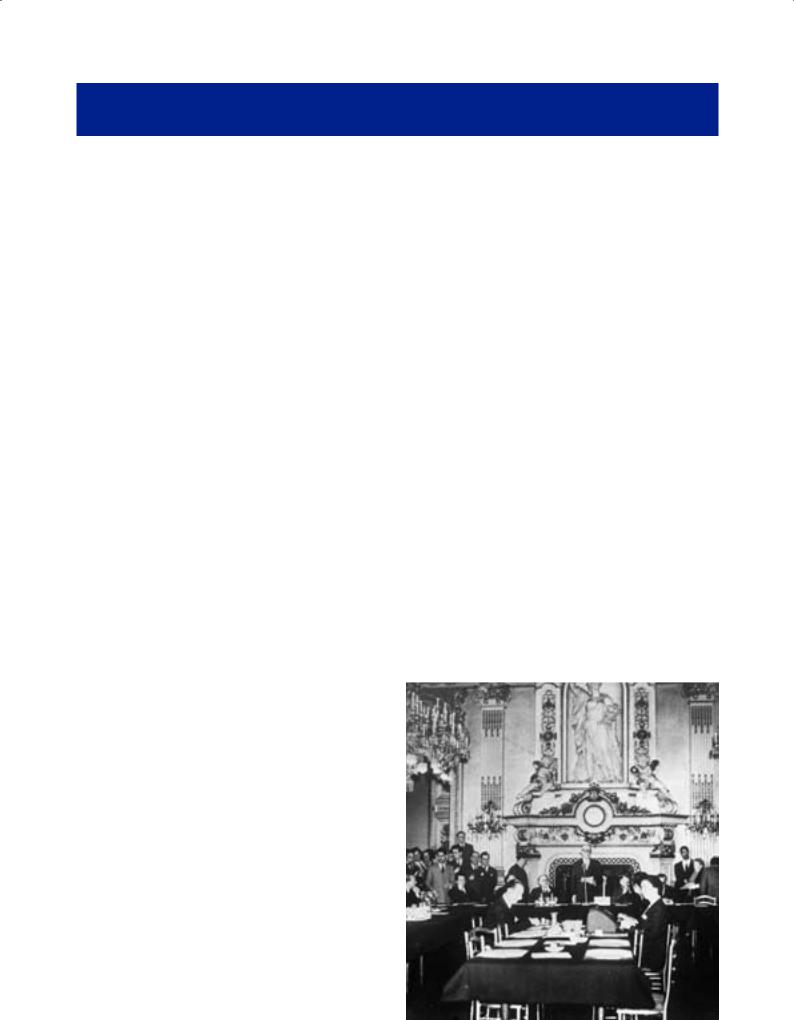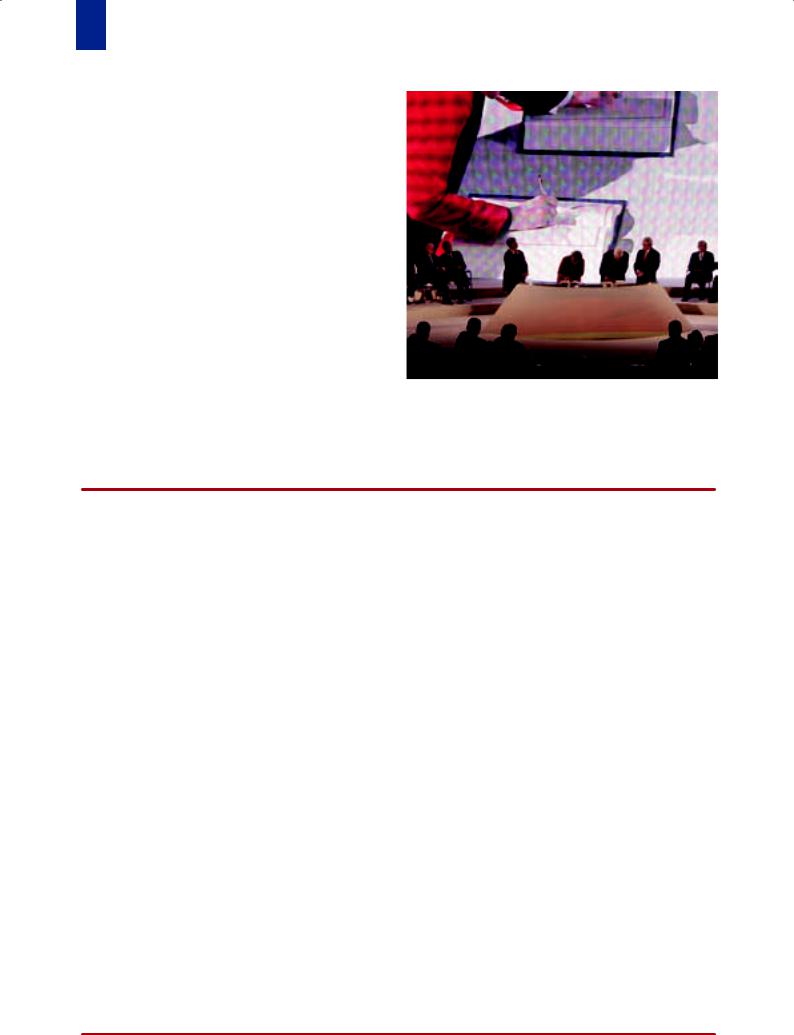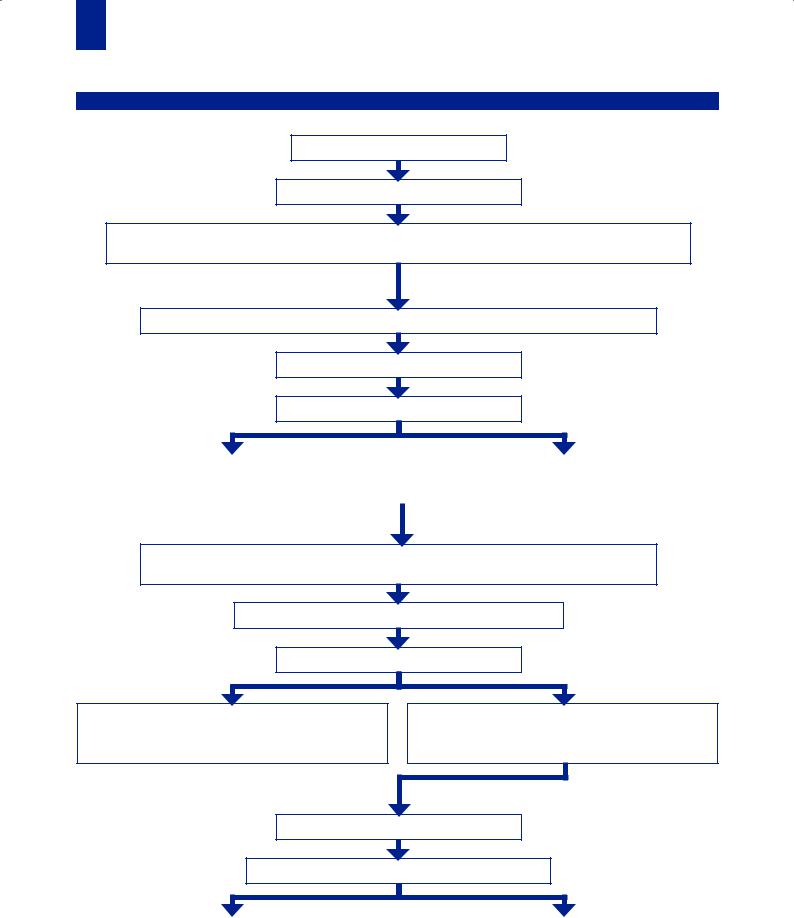
Для практ. заняття №3 Як працюють інституції ЄС (2013)
.pdf
T h e E u r o p e a n U n i o n e x p l a i n e d
Your guide to the EU institutions
How the
European Union works

The European Union
explained
This publication is a part of a series that explains what the EU does in different policy areas, why the EU is involved and what the results are. You can see online which ones are available and download them: europa.eu/pol/index_en.htm bookshop.europa.eu
How the European Union works 
Europe 2020: Europe’s growth strategy
The Founding Fathers of the European Union
Agriculture |
|
Borders and security |
|
Budget |
The European Union explained — |
Climate action |
How the European Union works |
Competition |
|
Consumers |
European Commission |
Culture and audiovisual |
Directorate-General for Communication |
Customs |
Publications |
Development and cooperation |
1049 Brussels |
Digital agenda |
BELGIUM |
Economic and monetary union and the euro |
|
Education, training, youth and sport |
Manuscript completed in June 2013 |
Employment and social affairs |
|
Energy |
Cover: © Luis Pedrosa |
Enlargement |
|
Enterprise |
40 pp. — 21 × 29.7 cm |
Environment |
ISBN 978-92-79-29988-9 |
Fight against fraud |
doi:10.2775/20055 |
Fisheries and maritime affairs |
|
Food safety |
Luxembourg: Publications Office of the European Union, |
Foreign affairs and security policy |
2013 |
Humanitarian aid and civil protection |
|
Internal market |
© European Union, 2013 |
Justice, citizenship, fundamental rights |
Reproduction is authorised. For any use or reproduction |
Migration and asylum |
of individual photos, permission must be sought directly |
Public health |
from the copyright holders. |
Regional policy |
|
Research and innovation |
Printed in Italy |
Taxation |
|
Trade |
Printed on white chlorine-free paper |
Transport |
|

T h e E u r o p e a n
U n i o n e x p l a i n e d
How the
European Union works
Your guide to the
EU institutions

2
Contents
H o w t H E E u R O P E A N U n I O N w o R k s
Introducing the European Union: how it works, who does what |
3 |
The European Parliament: the voice of the people |
9 |
The European Council: setting the strategy |
12 |
The Council: the voice of the Member States |
14 |
The European Commission: promoting the common interest |
19 |
The national parliaments: enforcing subsidiarity |
23 |
The Court of Justice: upholding EU law |
24 |
The European Central Bank: ensuring price stability |
26 |
The European Court of Auditors: helping to improve EU financial management |
29 |
The European Economic and Social Committee: the voice of civil society |
31 |
The Committee of the Regions: the voice of local government |
33 |
The European Ombudsman: investigating your complaints |
34 |
The European Data Protection Supervisor: protecting your privacy |
35 |
The European Investment Bank: investing in the future |
36 |
The EU agencies |
38 |

Y o U R g U I D E t O t H E E U i N S T I T U T I O N S |
3 |
|
Introducing the European Union
How it works, who does what
What this publication is about
This publication is a guide on how the European Union (EU) works. ‘How the EU works’ means: how decisions are taken at EU level and who takes those decisions.
At the heart of this decision-making process are the EU institutions — such as the Parliament, the Council and the European Commission — which you may have heard of, and there are others. To show how the EU works, this publication first explains how EU legislation is made. It then gives further insight into each of the EU institutions, as well as the agencies and bodies supporting them.
The European Union in brief
At the core of the EU are the Member States —
the 28 countries that belong to the Union — and their citizens. The unique feature of the EU is that, although these are all sovereign, independent countries, they have pooled some of their ‘sovereignty’ in order to gain strength and the benefits of size. Pooling sovereignty means, in practice, that the Member States delegate some of their decision-making powers to the shared institutions they have created, so that decisions on specific matters of joint interest can be made democratically at European level. The EU thus sits between the fully federal system found in the United States and the loose, intergovernmental cooperation system seen in the United Nations.
The EU has achieved much since it was created in 1950. It has built a single market for goods and services that spans 28 countries with over 500 million citizens free to move and settle where they wish. It created the single currency — the euro — now a major world currency, and which makes the single market more efficient. It is also the largest supplier of development and humanitarian aid programmes in the world. These are just a few of the achievements so far. Looking ahead, the EU is working to get Europe out of the current economic crisis. It is at the forefront of the fight against climate change and its consequences; as it plans to keep growing, it helps neighbouring countries prepare themselves for EU membership; and it is building a common foreign policy which will do much to extend European values around
the world. The success of these ambitions depends on the ability to take effective and timely decisions and to implement them well.
The EU treaties
The European Union is based on the rule of law. This means that every action taken by the EU is
founded on treaties that have been approved voluntarily and democratically by all EU countries. The treaties are negotiated and agreed by all the EU Member States and then ratified by their parliaments or by referendum.
The treaties lay down the objectives of the European Union, the rules for EU institutions, how decisions are made and the relationship between the EU and its Member States. They have been amended each time new Member States have joined. From time to time, they have also been amended to reform the European Union’s institutions and to give it new areas of responsibility.
© ImageGlobe
On 9 May 1950, French Foreign Minister Robert Schuman first publicly proposed the ideas that led to the European Union. So 9 May is celebrated as the EU’s birthday.

4 |
H o w t H E E u R O P E A N U n I O N w o R k s |
|
The last amending treaty — the Lisbon Treaty — was signed in Lisbon on 13 December 2007, and came into force on 1 December 2009. Earlier treaties are now incorporated into the current consolidated version, which comprises the Treaty on European Union and the Treaty on the Functioning of the European Union.
The Treaty on Stability, Coordination and Governance in the Economic and Monetary Union is an intergovernmental treaty which was signed by all EU Member States except the Czech Republic and the United Kingdom in March 2012 and entered into force on 1 January 2013 in all Member States which
completed the ratification process. It is not an EU treaty, but an intergovernmental treaty and the intention is to bring it into EU law eventually. It is designed to foster budgetary discipline, strengthen the coordination of economic policies and to improve the governance of the euro area. At present 17 EU countries use the euro as their currency.
© ImageGlobe
The work of the EU is based on the treaties agreed by all the member countries — the latest main update was signed in Lisbon in 2007.
A history of the EU treaties
When French Foreign Minister Robert Schuman proposed integrating western Europe’s coal and steel industries in 1950, his ideas were set out in the Treaty of Paris the following year, and the precursor to the EU — the European Coal and Steel Community — was born. Since then, the EU has regularly updated and added to the treaties to ensure effective policy and decision-making.
XXThe Treaty of Paris, establishing the European Coal and Steel Community, was signed in Paris on 18 April 1951 and entered into force in 1952. It expired in 2002.
XXThe Treaties of Rome, establishing the European Economic Community (EEC) and the European Atomic Energy Community (Euratom), were signed in Rome on 25 March 1957 and came into force in 1958.
XXThe Single European Act (SEA) was signed in February 1986 and came into force in 1987. It amended the EEC Treaty and paved the way for completing the single market.
XXThe Treaty on European Union — the Maastricht Treaty — was signed in Maastricht on 7 February 1992 and came into force in 1993. It established the European Union, gave the Parliament more say in decision-making and added new policy areas of cooperation.
XXThe Treaty of Amsterdam was signed on 2 October 1997 and came into force in 1999. It amended previous treaties.
XXThe Treaty of Nice was signed on 26 February 2001 and entered into force in 2003. It streamlined the EU institutional system so that it could continue to work effectively after the new wave of Member States joined in 2004.
XXThe Treaty of Lisbon was signed on 13 December 2007 and came into force in 2009. It simplified working methods and voting rules, created a President of the European Council and introduced new structures with a view to making the EU a stronger actor on the global stage.

Y o U R g U I D E t O t H E E U i N S T I T U T I O N S |
5 |
|
Who takes the decisions?
Decision-making at EU level involves various European institutions, in particular:
XXthe European Parliament, which represents the EU’s citizens and is directly elected by them;
XXthe European Council, which consists of the Heads of State or Government of the EU Member States;
XXthe Council, which represents the governments of the EU Member States;
XXthe European Commission, which represents the interests of the EU as a whole.
The European Council defines the general political direction and priorities of the EU but it does not exercise legislative functions. Generally, it is the European Commission that proposes new laws and it is the European Parliament and Council that adopt them.
The Member States and the Commission then implement them.
What types of legislation are there?
There are several types of legal acts which are applied in different ways.
XXA regulation is a law that is applicable and binding in all Member States directly. It does not need to be passed into national law by the Member States although national laws may need to be changed to avoid conflicting with the regulation.
XXA directive is a law that binds the Member States, or a group of Member States, to achieve a particular objective. Usually, directives must be transposed into national law to become effective. Significantly,
a directive specifies the result to be achieved:
it is up to the Member States individually to decide how this is done.
XXA decision can be addressed to Member States, groups of people, or even individuals. It is binding in its entirety. Decisions are used, for example, to rule on proposed mergers between companies.
XXRecommendations and opinions have no binding force.
How is legislation passed?
Every European law is based on a specific treaty article, referred to as the ‘legal basis’ of the legislation.
This determines which legislative procedure must be followed. The treaty sets out the decision-making process, including Commission proposals, successive readings by the Council and Parliament, and the opinions of the advisory bodies. It also lays down when unanimity is required, and when a qualified majority is sufficient for the Council to adopt legislation.
The great majority of EU legislation is adopted using the Ordinary Legislative Procedure. In this procedure, the Parliament and the Council share legislative power.
The freedom for all citizens to travel, live and work in all the 28 EU countries is one of the main achievements of the European Union.
© Heide Benser/Corbis

6 |
H o w t H E E u R O P E A N U n I O N w o R k s |
|
Ordinary Legislative Procedure
1.Proposal from the Commission
2.Opinions from national parliaments
3.Opinions from the European Economic and Social Committee and/or the Committee of the Regions
(when this is required)
FIRST READING
4.First reading by the European Parliament: Parliament adopts a position (amendments)
5.Commission can amend its proposal
6.First reading by the Council (*)
7. Council approves Parliament’s position. |
|
|
8. Council and Parliament disagree on amendments. |
||
The act is adopted |
|
|
Council adopts position at first reading |
||
|
|
|
|
|
|
|
|
|
|
|
|
|
|
|
|
|
|
SECOND READING
9. Second reading by the Parliament: Parliament approves the Council’s position at first reading — the act is adopted in ‘early second reading’ — or proposes amendments
10.Commission opinion on Parliament’s amendments
11.Second reading by the Council (*)
12. Council approves all Parliament’s amendments to the Council’s position at first reading.
The act is adopted
13. Council and Parliament disagree on amendments to the Council’s position at first reading
CONCILIATION
14.Conciliation Committee is convened
15.Conciliation Committee agrees on a joint text
16. Parliament and Council agree with the proposal |
|
17. Parliament and/or Council disagree with the |
from the Conciliation Committee, and |
|
proposal from the Conciliation Committee, and |
the act is adopted |
|
the act is not adopted |
|
|
|
(*)Council adopts its position by a qualified majority (the treaties provide for unanimity in a few exceptional areas). However, if the Council intends to deviate from the Commission’s proposal/opinion it adopts its position by unanimity.

Y o U R g U I D E t O t H E E U i N S T I T U T I O N S |
7 |
|
The procedure begins with the Commission. When considering launching a proposal for action,
the Commission often invites views on the topic from governments, business, civil society organisations and individuals. The opinions collected feed into a Commission proposal that is presented to the Council and Parliament. The proposal may have been made at the invitation of the Council, the European Council, the Parliament or European citizens, or it may have been made on the Commission’s own initiative.
The Council and the Parliament each read and discuss the proposal. If no agreement is reached at the second reading, the proposal is put before a ‘conciliation committee’ comprising equal numbers of Council and Parliament representatives. Commission representatives also attend the committee meetings and contribute to the discussions. Once the committee has reached an agreement, the agreed text is then sent to Parliament and the Council for a third reading, so that it can finally be adopted as law. In most cases, the Parliament votes on proposals by simple majority and the Council by qualified majority voting, whereby each Member State has a certain number of votes in line with its size and population. In some cases, unanimous voting is required in the Council.
Special procedures
Special legislative procedures are available depending on the subject of the proposal. In the Consultation Procedure, the Council is required to consult Parliament on a proposal from the Commission,
but is not required to accept Parliament’s advice. This procedure is only applicable in a few areas, such as internal market exemptions and competition
law. In the Consent Procedure, Parliament may accept or reject a proposal, but may not propose amendments. This procedure can be used when the proposal concerns the approval of an international treaty that has been negotiated. In addition, there are limited cases where the Council and the Commission, or the Commission alone, can pass legislation.
These bodies are:
XXthe European Economic and Social Committee, which represents civil society groups such as employers, trades unions and social interest groups;
XXthe Committee of the Regions, which ensures that the voice of local and regional government is heard.
In addition, other institutions and bodies may be consulted when a proposal falls within their area of interest or expertise. For example, the European Central Bank would expect to be consulted on proposals concerning economic or financial matters.
Citizens’ participation
By means of a ‘European Citizens’ Initiative’,
1 million EU citizens from at least one quarter of the EU Member States may invite the Commission to bring forward a legislative proposal on a particular issue. The Commission will carefully examine all initiatives that fall within the framework of its powers and that have been supported by 1 million citizens. An audition of the initiatives is done in the Parliament.
Such initiatives may therefore influence the work of the EU institutions, as well as the
public debate.
Who is consulted, who can object?
In addition to the Commission–Council–Parliament triangle, there are a number of advisory bodies that must be consulted when proposed legislation involves their area of interest. Even if their advice is not taken, this contributes to the democratic oversight of EU legislation by ensuring that it is subject to the
widest scrutiny.
© Bernd Vogel/Corbis
Citizens can now propose new laws, by means of the European Citizens' Initiative.

8 |
H o w t H E E u R O P E A N U n I O N w o R k s |
|
National oversight
National parliaments receive draft legislative acts at the same time as the European Parliament and the Council. They can give their opinion to ensure that decisions are taken at the most appropriate level. EU actions are subject to the principle of subsidiarity
— which means that, except in the areas where it has exclusive powers, the Union only acts where action will be more effective at EU level than at national level.
National parliaments therefore monitor the correct application of this principle in EU decision-making.
What decisions are taken
The treaties list the policy areas in which the EU can take decisions. In some policy areas, the EU has exclusive competence, which means that decisions are taken at EU level by the Member States meeting in the Council and the European Parliament. These policy areas cover customs, competition rules, monetary policy for the euro area and the conservation of fish and trade.
In other policy areas, there is shared competence between the Union and the Member States. This means that if legislation is passed at EU level, then these laws have priority. However, if no legislation is adopted at EU level, then the individual Member States may legislate at national level. Shared competence applies in many policy areas, such as the internal market, agriculture, the environment, consumer protection and transport.
In all other policy areas the decisions remain with the Member States. Thus, if a policy area is not cited in a treaty, the Commission cannot propose a law in that area. However, in some fields, such as the space sector, education, culture and tourism, the Union can support Member States’ efforts. And in others, such as overseas aid and scientific research, the EU can carry out parallel activities, such as humanitarian aid programmes.
Economic coordination
All EU countries are part of the Economic and Monetary Union (EMU), meaning that they coordinate their economic policymaking and treat economic decisions as a matter of common concern. Within the EMU, no institution alone is responsible for overall economic policy. These responsibilities are divided between the Member States and the EU institutions.
Monetary policy — which deals with price stability and interest rates — is managed independently by the European Central Bank (ECB) in the euro area, i.e. in those 17 countries which use the euro as their currency.
Fiscal policy — which concerns decisions about taxation, spending and borrowing — is the responsibility of the 28 Member State governments. So are the policies about labour and welfare. However, as fiscal decisions taken by one euro area Member State can have an impact throughout the euro area, these decisions must conform to rules set at EU level. Therefore, the coordination of sound public finances and structural policies is necessary for the EMU to function effectively and to ensure stability and growth. In particular, the economic crisis that began in 2008 highlighted the need to strengthen economic governance in the EU and in the euro area, by means of inter alia closer policy coordination, monitoring
and supervision.
The Council monitors Member States’ public finances and economic policies and can make recommendations to individual EU countries based on proposals from the Commission. It may recommend adjustment measures and sanction euro area countries that do not take corrective measures to reduce excessive deficit and debt levels.
The governance of the euro area and major economic policy reforms are also discussed in the Euro Summits, where Heads of State or Government of euro area members meet.
The EU and foreign relations
Relations with countries outside of the EU are under the responsibility of the High Representative of the Union for Foreign Affairs and Security Policy, who is appointed by the European Council, but also holds the post of European Commission Vice-President. At the level of Heads of State or Government, the Union is represented by the President of the European Council.
The European External Action Service (EEAS) serves as a foreign ministry and diplomatic service for the Union under the authority of the High Representative. It is composed of expert staff transferred from the Council, the Member States and the European Commission.
The Council develops and takes decisions in the field of the EU’s foreign and security policy on the basis of guidelines set by the European Council. The Commission, on the other hand, is responsible for trade and funding for non-EU countries, such as humanitarian or development aid. The Commission also represents the Union in all areas of EU competence outside foreign and security policy.
